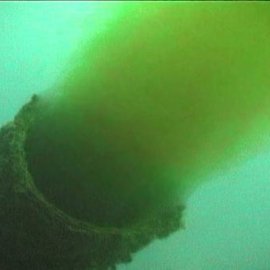Externalities
-
English
-
ListenPause
I’m Peter Neill, Director of the World Ocean Observatory.
Externality refers to what lies outside a given perimeter; in modern parlance, it often refers to a disconnected or unconsidered consequence, sometimes positive, sometimes not, of a particular action. For example, a factory is built in a municipality, enthusiastically welcomed by the residents, justified as stimulus for jobs, taxes, and a healthy community, which then, as a by-product of its manufacturing process, releases high quantities of mercury as waste into the nearby swamp or river which then descends through the towns below into the watershed and the ocean. That waste is toxic, and so it generates serious impacts along its downstream course, on the health of citizens below, on the continuum of terrestrial and riverine life, and ultimately on the marine food chain where it is ingested by fish, thereafter harvested and supplied to our table. All of that consequence, none of it monetized or factored into the cost of the factory or the price of its product, is called “externality.”
Hydraulic fracturing, open pit mining, dams and highways, filled wetlands—these are just some of the many other examples of human-engineered intrusion into natural systems that are not typically planned or valued within the full context and cost of their use.
I watched a remarkable short film recently wherein a passenger tossed a plastic water bottle out the window of a moving car; the bottle bounced and rolled across the pavement, into the ditch that drained into a river, into a city, into a culvert, drain, and canal, into the ocean. And there it descended, to the ocean floor where it disintegrated into tiny beads of plastic, dissolved its chemicals into the water where it joined the consequence of the disposal of millions of such bottles and contributed to the mass externality that is today’s ocean.
We are saturating the ocean with our unthinking consequence, be it plastic, or chemicals, or micro-particles—and succumbing to the greatest externality of them all—accelerating climate change that is already magnifying and amplifying the threat to every nurturing part of our ocean world.
I recently attended a conference sponsored by the Climate Change Institute at the University of Maine, a program that has collected and interpreted climate data, extrapolated from ice cores taken in the Artic, Antarctic, and Himalayas, and that has developed several tools for visualizing the demonstrable change in our natural environment over a 10,000 year period, and more. The data, along with so much other climate science, document the changing temperatures over time and the incidence of man-made chemicals and deposits that have accelerated over the past century at a critically increasing rate that is irrefutable and deeply disturbing.
The conference was attended by state agency managers, municipal officials, city planners, and interested individuals; its purpose was to give us the opportunity to play “what if.” What if we accept what the data tells us? What if we stipulate a certain degree of increasing temperature? What if we accept so many feet of sea level rise? What would be the specific consequences on the life of our coast, inland, and further into the wild ?
What would happen to fishing? To tourism? To jobs and taxes? To community health? And if we could identify those outcomes, what could we do it about them—near-term, mid-term, and long-term to mitigate the most immediate real consequence and to define the necessary change required to protect our livelihoods, our family, and these places where we live? We accepted the challenge, and we worked together to envision a way forward. Indeed, we began an exercise to plan for the future. We rated the threat of certain outcomes; we defined a range of responses; we set priorities for investment of time and resources; and we began to understand that, beyond denial, within the context of climate reality, there were things to be done, that could be done to visualize, design, price, and implement the community actions required to meet the challenge. We could see how something just might happen, just might work, and how that might accrue to hopeful community benefit.
It is simplistic and defeatist to deny the threat of climate change. Yes, it is complicated both to understand and to accept, and the easiest answer is to avoid the problem by denying its existence, or postpone its consideration, or leave it for the next generation. Excuses abound: too hard to do, too expensive, too disruptive to the status quo, too politically uncomfortable.
The externalities of climate change are real and dangerous. The hard question is: are we too cowardly and too irresponsible to confront them?
We will discuss these issues, and more, in future editions of World Ocean Radio.
Externality refers to a disconnected or unconsidered consequence. Hydrofracking, mountaintop removal, filled wetlands, carbon emissions, and plastic pollution are all examples of intrusion into natural systems where the full cost is not valued. In this episode of World Ocean Radio host Peter Neill will discuss the real, various, and dangerous externalities of climate change and will assert that to deny them is simplistic and defeatist.
About World Ocean Radio:
Peter Neill, Director of the World Ocean Observatory and host of World Ocean Radio, provides coverage of a broad spectrum of ocean issues from science and education to advocacy and exemplary projects. World Ocean Radio, a project of the World Ocean Observatory, is a weekly series of five-minute audio essays available for syndicated use at no cost by college and community radio stations worldwide.
World Ocean Radio Has Gone Global:
A selection of episodes is now available in Portuguese, Spanish, French, and Swahili. For more information, visit http://www.worldoceanobservatory.org/world-ocean-radio-global.
Image: The Delray Beach, Florida ocean outfall discharges 13 million gallons per day of treated sewage, up-current of a coral reef.
Credit: Steve Spring | Marine Photobank
Resources & Episode Notes
< Climate Change Institute
< Climate Adaptation and Sustainability Conference
- Login to post comments



